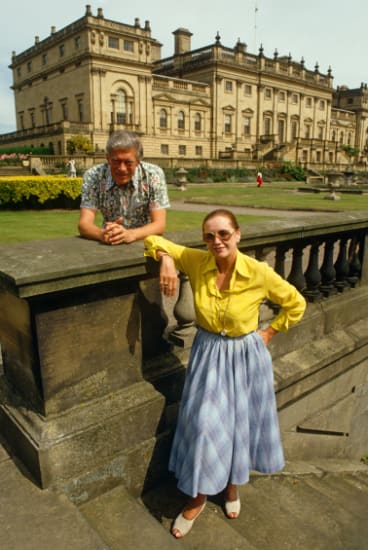Bueno, convengamos que cuando el Lascelles en cuestión inició su carrera en la corte (1920) su primo aún no formaba parte de la RF... y la Queen aún no había nacido para realizar enchufes.En resumen: Que a la Queen le ha sobrado parentela para enchufarla en los cargos a su servicio, y no me refiero al servicio doméstico, que a sus parientes se les caerían los anillos.
Navigation
Instalar el app
How to install the app on iOS
Follow along with the video below to see how to install our site as a web app on your home screen.
Se debe tener en cuenta: This feature may not be available in some browsers.
Más Opciones
Estás usando un navegador obsoleto. No se pueden mostrar estos u otros sitios web correctamente.
Se debe actualizar o usar un navegador alternativo.
Se debe actualizar o usar un navegador alternativo.
Hermana fiel: la Princesa Real Mary, condesa de Harewood
- AutorLady Susan Vernon
- Fecha de inicio
- Registrado
- 22 Jul 2017
- Mensajes
- 3.511
- Calificaciones
- 10.740
Bueno, convengamos que cuando el Lascelles en cuestión inició su carrera en la corte (1920) su primo aún no formaba parte de la RF... y la Queen aún no había nacido para realizar enchufes.
Sí, pero no cambia el hecho de que ella y su padre y abuelo han tenido y tiene un montón de parientes para enchufar y lo han hecho siempre. Supongo que piensan que el cotarro monárquico se salvaguarda mejor en familia.
- Registrado
- 22 Jul 2017
- Mensajes
- 3.511
- Calificaciones
- 10.740
La historia del hijo mayor de la Princesa Mary.George Henry Hubert Lascelles KBE, VII conde de Harewood (Londres, 7 de febrero de 1923 - 11 de julio de 2011) fue un melómano y promotor de ópera, empresario, crítico, escritor y filántropo británico
Un hombre que fué algo más que un aristócrata parásito.
George Lascelles, VII Conde de Harewood
(1923 - 2011)
La princesa Mary con sus dos hijos, George y Gerald, en 1932George Lascelles nació en Harewood House, Yorkshire, la mansión perteneciente a su familia. Era hijo de Henry Lascelles, VI conde de Harewood, y de María del Reino Unido, princesa real (única hija del rey Jorge V y de la reina María) y primo de la reina Isabel II del Reino Unido. Cuando nació ocupaba el sexto lugar en la línea de sucesión al Trono.
Fue educado primero en el Ludgrove School y más tarde en el Colegio Etony en el King's College de Cambridge. Tras graduarse, ingresó en la Guardia de Granaderos, donde fue ascendido al grado de capitán. Durante la Segunda Guerra Mundial sirvió en Argelia e Italia, donde fue hecho prisionero por los alemanes en Monte Corno y llevado al castillo de Colditz, donde permaneció como prisionero entre 1944 y marzo de 1945. Adolf Hitlerfirmó su sentencia de muerte pero el comandante de la prisión, viendo que la guerra estaba perdida, se negó a cumplir la orden y envió al prisionero a Suiza.
Entre 1945 y 1946 sirvió como edecán de lord Athlone, gobernador general de Canadá y en 1947, 1953-1954 y 1956 como consejero de Estado, siendo la primera persona sin título real que recibió tal nombramiento.
Promotor de música, llegó a ser director de la Royal Opera de Covent Garden en Londres entre 1950-53 y 1969-72 y director del Festival de Edimburgo entre 1961-65. Sirvió como mánager general de la Sadler's Well Opera, hoy English National Opera entre 1972-85. Fue mánager de Opera Australia y Opera North.
Fue director de la British Board of Film Classification entre 1980 y 1990.
Publicó y comentó la versión revisada del Kobbe Opera Book, referente del medio musical. Escribió crítica musical para The Nation y New Statesman entre otras publicaciones.
En 1968 mantuvo una larga entrevista con su amiga la cantante Maria Callas, que estaba recluida en su residencia en París, que se conoce como "The Callas Conversations", editada en CD y DVD.
Apasionado por el fútbol, fue presidente de la Asociación del Fútbol entre 1963 y 1972 y del Leeds United Association Football Club desde 1962 hasta su fallecimiento.
Se casó con Maria Stein (hija del pianista Erwin Stein) en 1949 y se divorció en 1967. Tuvieron tres hijos.
Volvió a casarse con Patricia "Bambi" Tuckwell (hija de Barry Tuckwell), con quien tuvo su cuarto hijo.
Publicó sus memorias "Las lenguas y los dientes " en 1981.
Fue condecorado caballero de la Orden del Imperio Británico y, en 2010, con la Orden de Australia.
Residió en un ala de la Harewood House en Yorkshire, que no se encontraba entre sus posesiones, en Leeds, donde tenía su colección de arte valorada en cincuenta millones de libras esterlinas.
Se le considera uno de los más importantes difusores de la música clásica en general y de la ópera en particular en el Reino Unido, habiendo promocionado la obra de Benjamin Britten, Leos Janacek, compositores ingleses y la primera versión de El anillo del nibelungo en inglés, en 1970, dirigida por Reginald Goodall.
Lo sucede su hijo David Lascelles (*1950) como VIII conde de Harewood.
¡Que buena pareja de abueletes hacían la Queen y su primo George, el gran melómano y mecenas de la música! De seguro que los británicos hubiesen visto con mejores ojos la boda de ambos que la de la Queen con el principe pobre y extranjero con quien se casó, figuraos, un héroe de guerra prisionero en la mítica prisión de Colditz y condenado a muerte por el propio Fürher, solo tres años mayor que ella! Pero la Queen desde jovencita tuvo claro que quería que el rubio guapísimo fuese suyo, jajajal
Pero ¿los Queenberry y los Lascelles son los mismos? Yo diria que pueden estar emparentados, pero no me consta que sean los mismos...
Me refería a la familia de la que había comentado el caso de legitimación, los Queensberry, no a los Harewood. Disculpa si te he llevado a la confusión.
Los Queensberry son una familia muy antigua de la nobleza escocesa, parte del clan Douglas.
Los Harewood, pese a esta reciente conexión real, son “nuevos” y la fortuna (con la que se construyó Harewood House, pero de la que no queda mucho, todo sea dicho) viene de esclavos y plantaciones en Barbados y las Indias Occidentales.
Última edición:
He ido a buscar la casa Harewood, que por fuera es una preciosidad y por dentro no he encontrado mucho una pena.
Harewood House: One of the most beautiful 18th-century country houses owned by the Lascelles family
XPress “Like”
to follow us on Facebook
Marija Georgievska

Built in the 18th century for wealthy plantation owner Edwin Lascelles, Harewood House is one of the most beautiful historic houses in England. It is located in Harewood near Leeds and was built between 1759 and 1771.
Edwin Lascelles was the 1st Baron Harewood, and throughout the centuries, the house remained in the ownership of his family. The architects who designed this grand mansion were John Carr and Robert Adam, and the landscape was one of the many amazing designs of Lancelot “Capability” Brown.
The mansion is one of the Treasure Houses of England which houses many valuable sculptures and paintings of famous artists. The exterior of the house was made of local millstone grit, and even the interior bricks came from the Baron’s land. Before the house was built Lascelles had been a very successful businessman, so he bought the estate of Gawthorpe.

The Harewood House owned by the Lascelles family. Author: Charlie Dave. CC BY 2.0
The family claim that they arrived in Britain with William the Conqueror during the Norman Conquest. They were settled in Yorkshire by 1315 and were known as de Lascelles. They were very powerful, and many members of the family were involved in Parliament and held important military positions.
At the end of the 17th century, the de Lascelles bought plantations in the West Indies, and the income allowed Henry Lascelles to buy the Harewood estate in 1738. The foundations of the house were laid in 1759, and it was completed by 1765. The designer Robert Adam was responsible for the interiors, and he made minor changes to the plans made by Carr and also added internal courtyards.

The dining room. Author: graham elsom. CC BY 2.0
The famous furniture-maker Thomas Chippendale was commissioned to fill the house with his most beautiful items famous through all England during the 18th century. Together, Adam and Chippendale created a perfect example of the English country house estate with classical elegance.

The yellow drawing room.
The mansion stayed in this state until the 1840s when a new architect was employed by the 3rd Earl of Harewood. His name was Sir Charles Barry, and he was hired to expand the house in order to more comfortably accommodate the Earl’s thirteen children. Extra bedrooms, formal terraces, and a third story were added, and the south portico was removed.

The state bedroom with a bed designed by Thomas Chippendale.
The most beautiful of these is the terrace garden under the south front. Today, the garden is a place for art exhibitions and special events. There is an adventure playground where visiting children can amuse themselves while their elders admire the surrounding grounds. One of the most popular sights is the bird garden, which contains 120 types of exotic birds, some of which are under threat of extinction. There are individual areas for some of them, such as the flamingos, cranes, and penguins. This garden is a member of the British and Irish Association of Zoos and Aquariums.

The old library.
In 1922, Viscount Henry Lascelles married Mary, the eldest daughter of King George V. The couple lived in Goldsborough House, but after the death of Henry’s father, they moved permanently into Harewood House. They added many fine art pieces through the years into the house’s collection. Today, the house remains in the ownership of the family, and the current Earl is David Lascelles.

The house’s kitchen. Author: graham elsom. CC BY 2.0
The Harewood House Trust manages the estate today, and it is open to the public throughout the year. The famous artist Joseph Turner painted the landscape in watercolor, and Elton John performed a concert on the grounds. Part of the estate was made into a village for the soap opera Emmerdale in 1996. The house was listed as grade I protected building, and many features surrounding it were also listed as Grade I and II.
Muy bonita, pero me quedo con Chatsworth en mis sueños, incluida biblioteca.
Gracias por el hilo. Bueno salir de KP para respirar campo.
Harewood House: One of the most beautiful 18th-century country houses owned by the Lascelles family
XPress “Like”
to follow us on Facebook
Marija Georgievska

Built in the 18th century for wealthy plantation owner Edwin Lascelles, Harewood House is one of the most beautiful historic houses in England. It is located in Harewood near Leeds and was built between 1759 and 1771.
Edwin Lascelles was the 1st Baron Harewood, and throughout the centuries, the house remained in the ownership of his family. The architects who designed this grand mansion were John Carr and Robert Adam, and the landscape was one of the many amazing designs of Lancelot “Capability” Brown.
The mansion is one of the Treasure Houses of England which houses many valuable sculptures and paintings of famous artists. The exterior of the house was made of local millstone grit, and even the interior bricks came from the Baron’s land. Before the house was built Lascelles had been a very successful businessman, so he bought the estate of Gawthorpe.
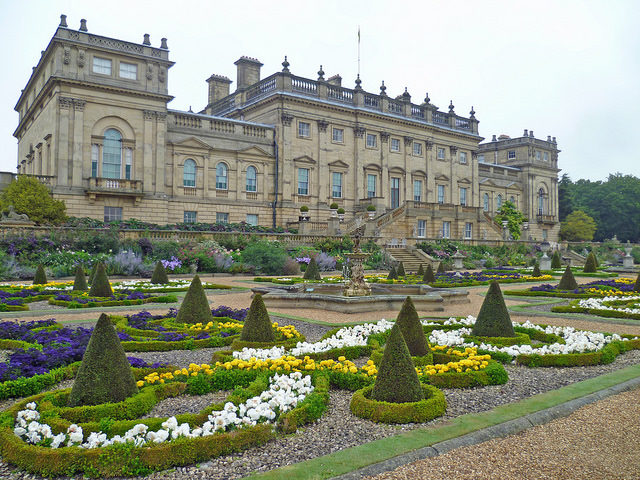
The Harewood House owned by the Lascelles family. Author: Charlie Dave. CC BY 2.0
The family claim that they arrived in Britain with William the Conqueror during the Norman Conquest. They were settled in Yorkshire by 1315 and were known as de Lascelles. They were very powerful, and many members of the family were involved in Parliament and held important military positions.
At the end of the 17th century, the de Lascelles bought plantations in the West Indies, and the income allowed Henry Lascelles to buy the Harewood estate in 1738. The foundations of the house were laid in 1759, and it was completed by 1765. The designer Robert Adam was responsible for the interiors, and he made minor changes to the plans made by Carr and also added internal courtyards.
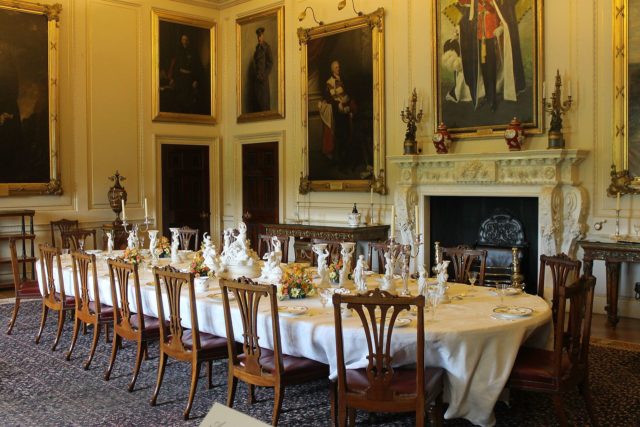
The dining room. Author: graham elsom. CC BY 2.0
The famous furniture-maker Thomas Chippendale was commissioned to fill the house with his most beautiful items famous through all England during the 18th century. Together, Adam and Chippendale created a perfect example of the English country house estate with classical elegance.
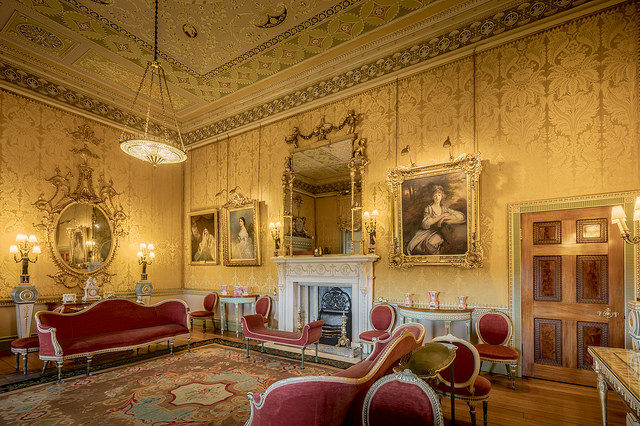
The yellow drawing room.
The mansion stayed in this state until the 1840s when a new architect was employed by the 3rd Earl of Harewood. His name was Sir Charles Barry, and he was hired to expand the house in order to more comfortably accommodate the Earl’s thirteen children. Extra bedrooms, formal terraces, and a third story were added, and the south portico was removed.
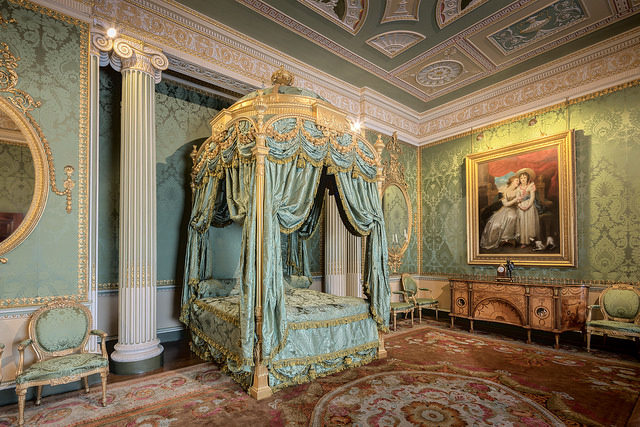
The state bedroom with a bed designed by Thomas Chippendale.
The most beautiful of these is the terrace garden under the south front. Today, the garden is a place for art exhibitions and special events. There is an adventure playground where visiting children can amuse themselves while their elders admire the surrounding grounds. One of the most popular sights is the bird garden, which contains 120 types of exotic birds, some of which are under threat of extinction. There are individual areas for some of them, such as the flamingos, cranes, and penguins. This garden is a member of the British and Irish Association of Zoos and Aquariums.
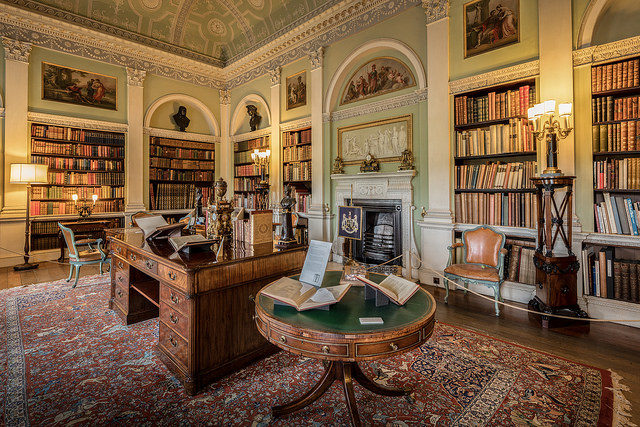
The old library.
In 1922, Viscount Henry Lascelles married Mary, the eldest daughter of King George V. The couple lived in Goldsborough House, but after the death of Henry’s father, they moved permanently into Harewood House. They added many fine art pieces through the years into the house’s collection. Today, the house remains in the ownership of the family, and the current Earl is David Lascelles.
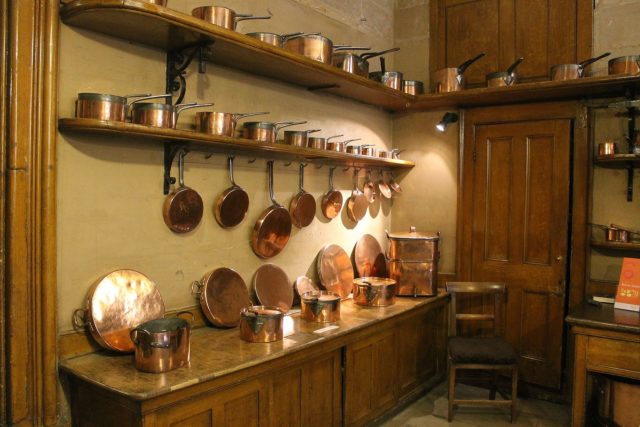
The house’s kitchen. Author: graham elsom. CC BY 2.0
The Harewood House Trust manages the estate today, and it is open to the public throughout the year. The famous artist Joseph Turner painted the landscape in watercolor, and Elton John performed a concert on the grounds. Part of the estate was made into a village for the soap opera Emmerdale in 1996. The house was listed as grade I protected building, and many features surrounding it were also listed as Grade I and II.
Muy bonita, pero me quedo con Chatsworth en mis sueños, incluida biblioteca.
Gracias por el hilo. Bueno salir de KP para respirar campo.
He ido a buscar la casa Harewood, que por fuera es una preciosidad y por dentro no he encontrado mucho una pena.
Harewood House: One of the most beautiful 18th-century country houses owned by the Lascelles family
XPress “Like”
to follow us on Facebook
Marija Georgievska
Built in the 18th century for wealthy plantation owner Edwin Lascelles, Harewood House is one of the most beautiful historic houses in England. It is located in Harewood near Leeds and was built between 1759 and 1771.
Edwin Lascelles was the 1st Baron Harewood, and throughout the centuries, the house remained in the ownership of his family. The architects who designed this grand mansion were John Carr and Robert Adam, and the landscape was one of the many amazing designs of Lancelot “Capability” Brown.
The mansion is one of the Treasure Houses of England which houses many valuable sculptures and paintings of famous artists. The exterior of the house was made of local millstone grit, and even the interior bricks came from the Baron’s land. Before the house was built Lascelles had been a very successful businessman, so he bought the estate of Gawthorpe.
The Harewood House owned by the Lascelles family. Author: Charlie Dave. CC BY 2.0
The family claim that they arrived in Britain with William the Conqueror during the Norman Conquest. They were settled in Yorkshire by 1315 and were known as de Lascelles. They were very powerful, and many members of the family were involved in Parliament and held important military positions.
At the end of the 17th century, the de Lascelles bought plantations in the West Indies, and the income allowed Henry Lascelles to buy the Harewood estate in 1738. The foundations of the house were laid in 1759, and it was completed by 1765. The designer Robert Adam was responsible for the interiors, and he made minor changes to the plans made by Carr and also added internal courtyards.
The dining room. Author: graham elsom. CC BY 2.0
The famous furniture-maker Thomas Chippendale was commissioned to fill the house with his most beautiful items famous through all England during the 18th century. Together, Adam and Chippendale created a perfect example of the English country house estate with classical elegance.
The yellow drawing room.
The mansion stayed in this state until the 1840s when a new architect was employed by the 3rd Earl of Harewood. His name was Sir Charles Barry, and he was hired to expand the house in order to more comfortably accommodate the Earl’s thirteen children. Extra bedrooms, formal terraces, and a third story were added, and the south portico was removed.
The state bedroom with a bed designed by Thomas Chippendale.
The most beautiful of these is the terrace garden under the south front. Today, the garden is a place for art exhibitions and special events. There is an adventure playground where visiting children can amuse themselves while their elders admire the surrounding grounds. One of the most popular sights is the bird garden, which contains 120 types of exotic birds, some of which are under threat of extinction. There are individual areas for some of them, such as the flamingos, cranes, and penguins. This garden is a member of the British and Irish Association of Zoos and Aquariums.
The old library.
In 1922, Viscount Henry Lascelles married Mary, the eldest daughter of King George V. The couple lived in Goldsborough House, but after the death of Henry’s father, they moved permanently into Harewood House. They added many fine art pieces through the years into the house’s collection. Today, the house remains in the ownership of the family, and the current Earl is David Lascelles.
The house’s kitchen. Author: graham elsom. CC BY 2.0
The Harewood House Trust manages the estate today, and it is open to the public throughout the year. The famous artist Joseph Turner painted the landscape in watercolor, and Elton John performed a concert on the grounds. Part of the estate was made into a village for the soap opera Emmerdale in 1996. The house was listed as grade I protected building, and many features surrounding it were also listed as Grade I and II.
Muy bonita, pero me quedo con Chatsworth en mis sueños, incluida biblioteca.
Gracias por el hilo. Bueno salir de KP para respirar campo.
Prima, si te gustan las grandes casas de la nobleza, échale un vistazo a las de los Buccleuch, que están como ancladas en su época, cada una de ellas en su estilo, y son preciosas. Boughton House en Inglaterra y Drumlanrig Castle y Bowhill House en Escocia.
- Registrado
- 22 Jul 2017
- Mensajes
- 3.511
- Calificaciones
- 10.740
Me refería a la familia de la que había comentado el caso de legitimación, los Queensberry, no a los Harewood. Disculpa si te he llevado a la confusión.
Los Queensberry son una familia muy antigua de la nobleza escocesa, parte del clan Douglas.
Los Harewood, pese a esta reciente conexión real, son “nuevos” y la fortuna (con la que se construyó Harewood House, pero de la que no queda mucho, todo sea dicho) viene de esclavos y plantaciones en Barbados y las Indias Occidentales.
Sí, es lo que dice la Wikipedia que he colgado en los anteriores post.
@Lady Susan Vernon me acordé de ti.
Gracias @Claudina lo dejo para mañana o no duermo que acabo de descubrir la pagina oficial. Estoy en la biblioteca y me queda mucho.
Estoy en la biblioteca y me queda mucho.


Gracias @Claudina lo dejo para mañana o no duermo que acabo de descubrir la pagina oficial.
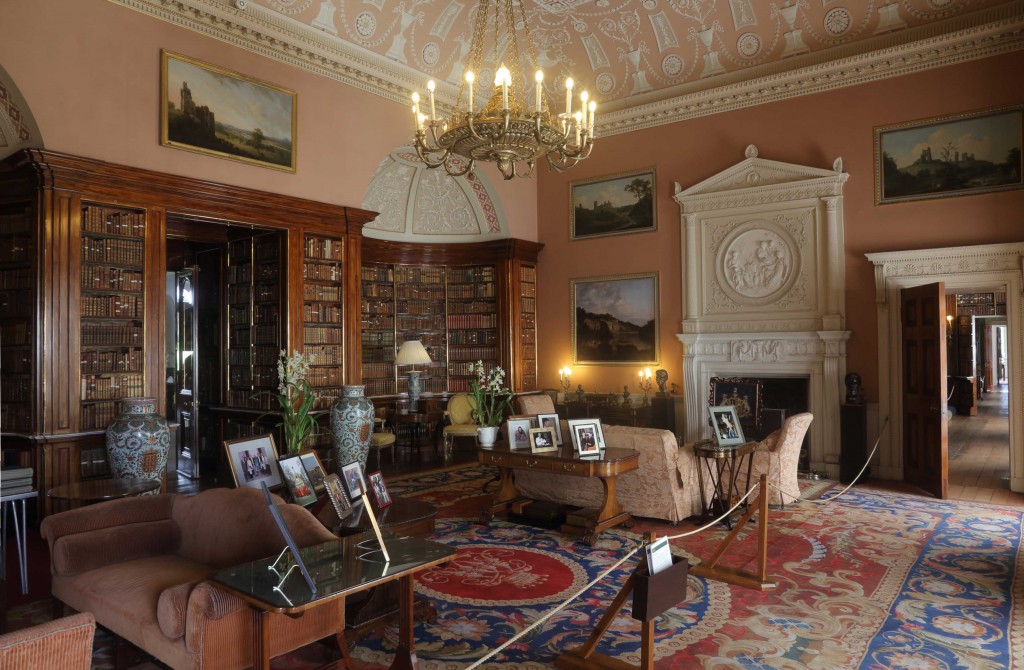

- Registrado
- 22 Jul 2017
- Mensajes
- 3.511
- Calificaciones
- 10.740
@Lady Susan Vernon me acordé de ti.
Gracias @Claudina lo dejo para mañana o no duermo que acabo de descubrir la pagina oficial.Estoy en la biblioteca y me queda mucho.
A veces dudo si son palacios o tiendas de fotos un poco recargadas en decoración, jajajaja...
Y pobre del que se choque con uno de esos jarrones, le arruinan la vida teniendo que pagarlos.
A veces dudo si son palacios o tiendas de fotos un poco recargadas en decoración, jajajaja...
Y pobre del que se choque con uno de esos jarrones, le arruinan la vida teniendo que pagarlos.
Hay una biblioteca inmensa y te fijas en los jarrones
Esta no tiene jarrones y además es la Spanish Library.
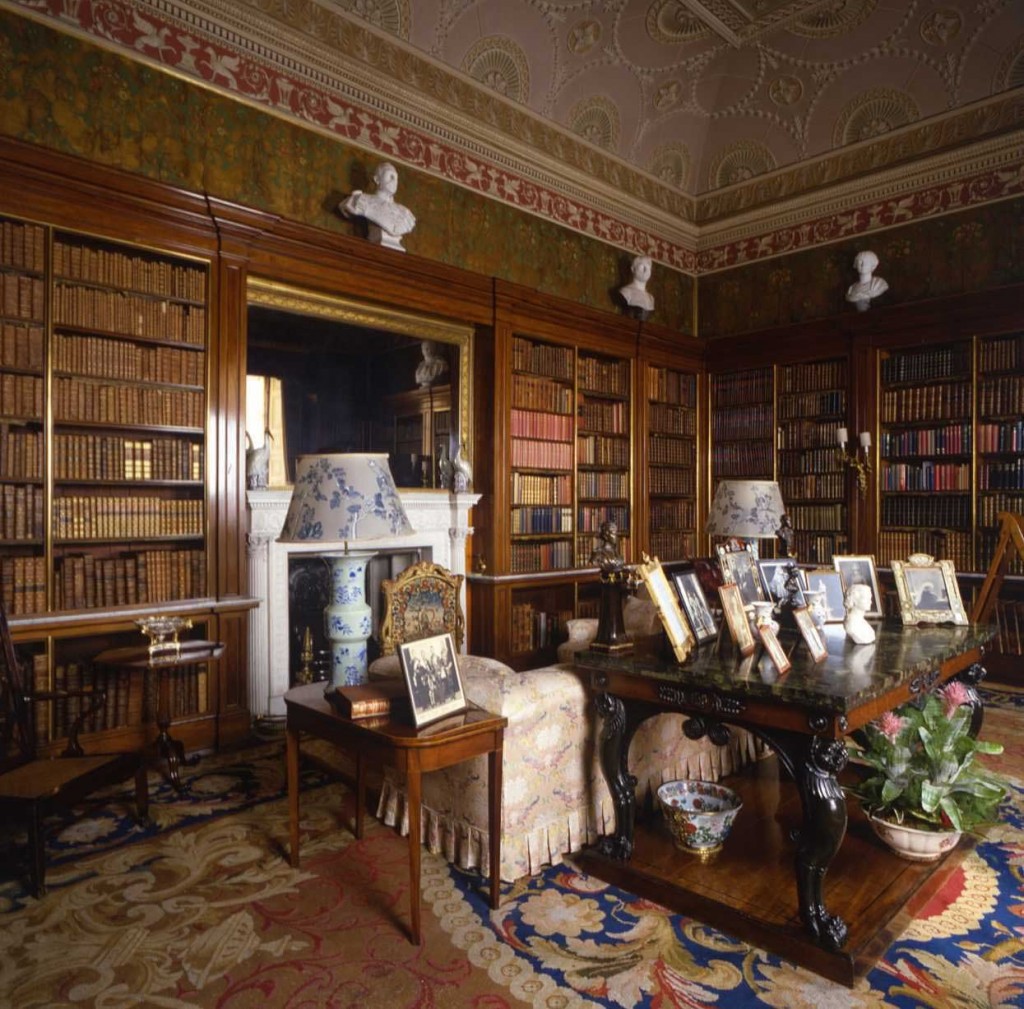
Y la antigua.
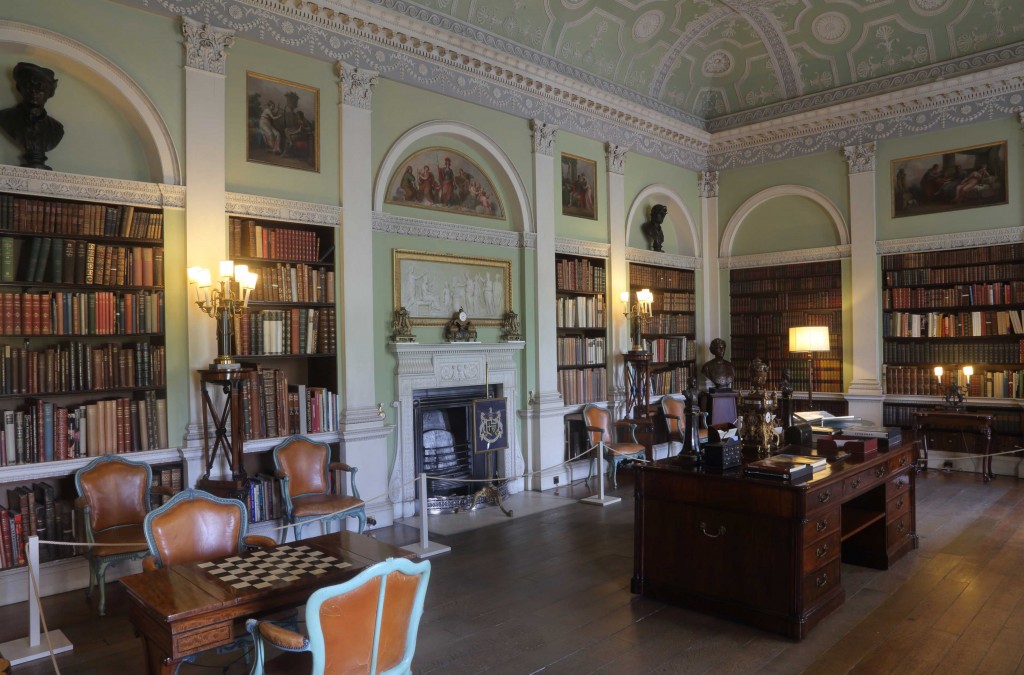
- Registrado
- 22 Jul 2017
- Mensajes
- 3.511
- Calificaciones
- 10.740
Sí, porque esos pedazos de jarrones parecen querer eclipsar cualquier cosa que haya alrededor, parecen soldados barrigones en la puerta.
La biblioteca, sí, decimonónica, seguro que comprarían los libros a granel para llenarla, con los lomos de color idéntico para que hiciesen juego con el mobiliario. Ahora parece que tiene libros más nuevos, seguro que la mayoría los compraría el conde George, el hijo de la Princesa Mary, le pega siendo un hombre con tanto amor a la música y, supongo, cultura en general.
Y me pregunto a quienes representarán los bustos de los dinteles, como si fuesen romanos aunque desde luego que no lo son.
La biblioteca, sí, decimonónica, seguro que comprarían los libros a granel para llenarla, con los lomos de color idéntico para que hiciesen juego con el mobiliario. Ahora parece que tiene libros más nuevos, seguro que la mayoría los compraría el conde George, el hijo de la Princesa Mary, le pega siendo un hombre con tanto amor a la música y, supongo, cultura en general.
Y me pregunto a quienes representarán los bustos de los dinteles, como si fuesen romanos aunque desde luego que no lo son.
Temas Similares
- Respuestas
- 17
- Visitas
- 681
- Respuestas
- 13
- Visitas
- 663
- Respuestas
- 282
- Visitas
- 5K
- Respuestas
- 150
- Visitas
- 3K




